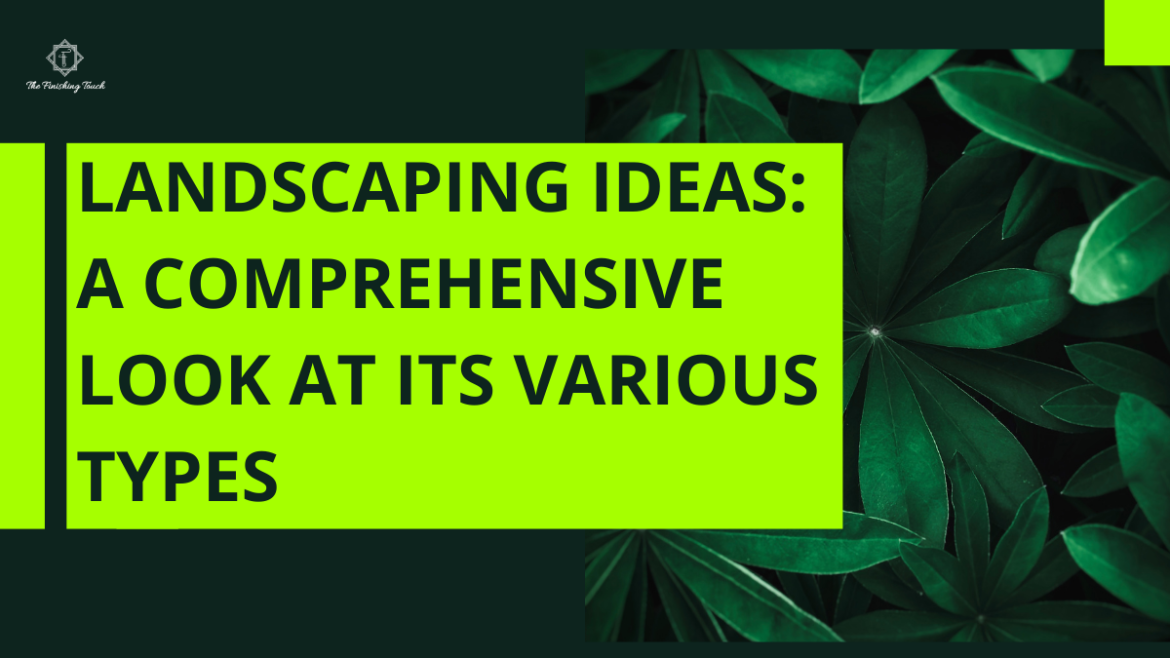Landscaping Ideas: A Comprehensive Look at Its Various Types

Landscaping gives a makeover to outdoor spaces using both science and art. It is used to create fruitful areas that enhance the natural atmosphere. If you want to make your house look beautiful from outside or have a garden in mind, you should understand the types of landscaping available.
In this complete guide, we will examine different types of landscaping ideas, look at which outdoor and nursery plants grow under different conditions as well as advice on special types of landscapes like Pergola Landscaping in Kolkata.
What is Landscaping?
Landscaping incorporates a variety of activities and designs ranging from simple garden bed arrangements to complex outdoor renovations. Creating an appealing environment inside out is the main intention behind it. There are several things that make up landscaping including:
• Softscape:
This refers to the living parts of landscaping such as trees, shrubs, flowers and grass. Softscape emphasizes on choosing plants, where they should be placed and their proper care thereby creating an attractive yet ecologically sustainable landscape.
• Hardscape:
There are several types of hardscape, including patios, walkways, retaining walls and pergolas. These structures give shape and purpose to landscapes through designated areas that facilitate their use.
• Water features:
Fountains, ponds and waterfalls are some examples of water features you can find in landscapes. Incorporating these elements creates a relaxing atmosphere which helps homeowners feel at peace when they spend time outdoors.
Landscaping Types
1. Residential Landscaping
Residential landscaping is about improving the outside zones of private houses. It includes making beautiful front yards, backyards, gardens and patios that match the architectural style of a home and the preferences of the occupants.
Key Elements:
- Lawn and Garden Beds:
The lawns are carefully watered while the gardens are rich in colors.
- Plants that grow outdoors:
The choice of a mix of outdoor plants like perennials, annuals and shrubs makes it interesting with texture and color.
- Functional Areas:
This includes features like patios, decks, and outdoor kitchens which serve as places where relaxation is possible.
2. Commercial Landscaping
The purpose of commercial landscaping is to provide businesses and other public spaces with beautiful yet practical outdoor areas. It beautifies the exterior of business premises in order to capture the attention of customers as well as clients.
Key Elements:
- Curb Appeal:
Good entrances; well-kept lawns; colorful plantings make it look good from outside..
- Sustainable Practices:
Utilization of indigenous plants combined with environmentally-friendly practices lead to reduction in maintenance cost hence lessening on harm to the environment..
- Public Spaces:
Establishing pleasant outdoor places to employees as well as visitors like courtyards, seating areas, walking paths.
3. Sustainable Landscaping
Sustainable landscaping is about the making of outdoor spaces that are friendly to the environment and also minimize resource intake. Key points are native plants, used as much as possible by human beings; saving water; eco-friendly materials.
Main Components:
- Native Plants:
Use of local flora reduces the need for water and maintenance.
- Water Conservation:
Using drip irrigation systems or rainwater harvesting techniques can retard evaporation, thus preventing wastage.
- Eco-Friendly Materials:
Hardscape components made with recycled and natural resources deliver a lower ecological footprint.
4. Xeriscaping:
Xeriscaping means landscaping specifically designed for places where there is little amount of water accessible. The emphasis is on drought-resistant plants and other methods which will help in achieving a pleasing landscape with lesser care.
Key Elements:
- Drought Tolerant Plants:
When opting for plants that thrive under dry conditions, one can go for fewer amounts of moisture.
- Efficient Irrigation:
Drip irrigation systems together with mulch retention save more water.
- Soil Improvement:
Incorporation of organic matter into the soil enhances its ability to hold moisture.
5. Japanese Landscape Design
Japanese landscaping, which is a traditional kind of garden design, primarily emphasizes simplicity, natural beauty as well as tranquility. Consequently, it makes use of water features, rocks and stones together with well maintained plants so that they can create peaceful environments. Japanese Gardens, Commonly Known for Their Simple Form and Natural Beauty, This Surpassing All Others as Tranquility, Incorporates Water Feature for Instance. Besides, the inclusion of rocks and stones together with well-kept plants are made entirely for making serene surroundings.
Essential Components:
- Water Elements:
Ponds, streams, and fountains induce a tranquillity sensation.
- Rocks and Stones:
They bring structure when placed in a natural arrangement that brings about balance.
- Sparse Planting:
It uses limited species of trees that starts by focusing on their shapes.
6. Mediterranean Landscape Architecture
Coastal areas of South Europe served as the source of inspiration for Mediterranean landscape design. Warm colors characterize the area plus aromatic vegetation together with outdoor living spaces which merge with nature.
Key Aspects:
- Warm Coloured Blooming Plants:
They include olive trees, lavender flowers and rosemary bushes amongst other citrus plants that provide greens plus some scent within your garden.
- Terracotta Tiles and Rocks:
This is epitomized through use of clay pots made from terracotta material combined with natural stone walls and patios adorned with tiles.
- Outdoor Living:
Spaces meant for dining plus relaxation have been designed such as pergolas or shaded seats made out from wood posts topped off by Long Grass.
7. Cottage Garden Landscaping
Generally speaking, there’s nothing that quite compares to cottage garden landscaping in terms of its spontaneous and sentimental aspects. It posits a haphazardly charming mixture of bright blooms, herbs as well as vegetables.
Key Elements:
- Dense Planting:
Many different kinds of plants are bunched together to create a lush, spilling-over appearance.
- Mixed Borders:
Having flowers, herbs, and vegetables together in garden beds creates diversity and beauty.
- Rustic Features:
Items like picket fences, arbors, or old-fashioned benches contribute to the beauty of a cottage garden.
The Role of Outdoor and Nursery Plants
1. Outdoor Plants
The outdoor plants are among those that provide life in landscapes with an element of vibrancy. They offer color, texture, and seasonality which turns outdoor areas into more inviting places where people can spend time comfortably while enjoying their beauty.
Popular Outdoor Plants:
- Perennials:
There are mostly those popular perennials like daylilies, histories, and peonies among others that live forever giving everlasting beauty.
- Annuals:
These flowers such as marigolds, petunias, and impatiens add splashes of color throughout the growing season.
- Shrubs:
The following shrubs include evergreens, hydrangeas, and lilacs which add structure as well as continuing engagement.
2. Potted Seedlings
Potted seedlings are grown in controlled environments prepared for planting in your garden; they ensure that you start with robust well-developed plants having higher survival chances.
Pointers On Selecting Nursery Plants
- Quality:
Look out more for vigorous foliage devoid of any diseases or pests in strong stems.
- Variety:
Nurseries include numerous species; therefore they will have other plants that could seldom be found or even new ones.
- Expert opinion:
The personnel at nurseries can provide useful information concerning the choice and management of plants.
Specialized Landscape Designs
Pergola Landscaping in Kolkata
Some outdoor areas might seem like they lack a little something. That something could be the trendiest pergola design that would improve both the style and function of open-air spaces. Here in Kolkata, where it is hot and humid many times a year, pergolas help provide much-needed shade and make amazing outdoor living spaces.
Advantages of Pergola Landscaping:
- Shade and Comfort:
The sun’s rays are also blocked by pergolas which make outside areas less unbearable.
- Aesthetic Appeal:
They add architectural interest and can be adorned with climbing plants like bougainvillea and jasmine.
- Versatility:
Pergolas can be used for dining, lounging or as a focal point in the garden.
For more specialized designs, consider consulting with landscape architects who can tailor the design to your specific needs and preferences.
Conclusion
Landscaping is a versatile field with many opportunities for improving outdoor areas. Whether residential or commercial, sustainable or xeriscaping, everyone’s preferences can be met through landscaping design. This means that it is possible to create a beautiful as well as functional garden by diversifying outdoor plants and purchasing high-quality nursery plants.
If you are interested in creating tranquil Japanese home gardens or colorful Mediterranean oases then take time to visualize your ideas carefully before going on and picking features that match your style of living. An appropriate approach will help to convert your backyard into an amazing landscape that would provide happiness and peace throughout life.

